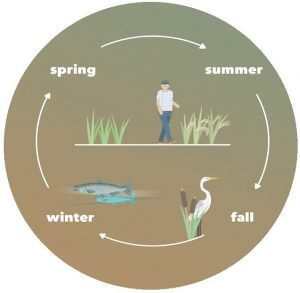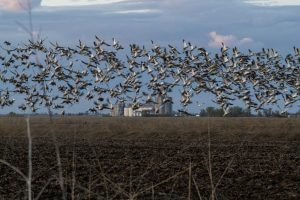By Todd Manley
At the end of the growing season, as the Sacramento Valley transitions from summer to fall, we shift from the agronomic season to the bird season as waterfowl, shorebirds, raptors and other birds traveling along the Pacific Flyway begin to arrive as part of their annual migration. Birds and other species using the Pacific Flyway are reliant upon varied land uses in the Sacramento Valley that include ricelands and managed wetlands (both privately managed wetlands and public refuges and state wildlife areas) to meet their habitat needs. Much of the habitat value of these lands (food, safe resting areas and for some species nesting areas) is dependent upon surface water deliveries. Because of the magnitude of habitat usually available in the Sacramento Valley, it serves a vital role to birds using the Pacific Flyway. This year, that role has a heightened level of importance, as the birds that arrive in the Valley will have traveled through a Flyway that is in the middle of a west-wide drought.

Last winter, as it became more apparent that 2021 was going to be a drought year, water managers, refuge managers and bird conservation organizations began to meet to discuss actions that could be taken to prepare for this winter. With the unprecedented lack of runoff this year and heightened criteria guiding reservoir operations to benefit fish species, it was apparent that it was highly unlikely that there would be much surface water available this fall and winter to create Flyway habitat, particularly on the west side of the Sacramento Valley. As we continued to meet during the spring and summer months, we were able to develop a plan to use the limited water and land resources that are available to the greatest extent possible to maximize habitat for Pacific Flyway species this year. This collaborative effort looks to use any management action available to local landowners, water management entities, refuge managers, conservation organizations and regulatory agencies to create habitat in the region to benefit birds this winter. The following is a description of those actions.
- Surface Water Deliveries – There will be some limited surface water supplies available this fall in Yuba, Placer and Butte Counties, which will be delivered to irrigate habitat on harvested rice ground and managed wetlands.
- Refuge Water Deliveries – The National Wildlife Refuges and State Wildlife Areas in the Sacramento Valley experienced cuts to their water supplies this year in accordance with their contracts. The refuge managers are coordinating with the water management entities to ensure that the allocated water is delivered in time to provide benefits for the arriving birds and, where available, will be pumping groundwater to irrigate habitat.
- Landowner Actions – The California Waterfowl Association and Ducks Unlimited, working with the California Rice Commission created a flyer, which has been widely distributed to rice growers in the region, informing them of actions they could take, including replacing boards in water control structures to retain water in fields if rainfall occurs, to create habitat on their ricelands.
- Groundwater – A coalition in the Sacramento Valley has been working with state and federal agencies to secure funding to help augment irrigated habitat with groundwater, where appropriate, to maximize habitat values while protecting groundwater sustainability. This was prioritized by the Governor in his May 10 proclamation (7c). See coalition letter.
- Regulatory Actions – During the last drought in 2014-15, the State Water Resources Control Board (SWRCB) performed some creative regulatory actions to allow for timely diversion of water during the winter months that greatly increased the habitat available to birds that winter. Entities that worked with the SWRCB, will be doing so again this winter to collaborate once again on these creative actions, which are described in a document developed late last year. This will include the suspension of water rights curtailments when we see precipitation later this year.

During a drought year like we are experiencing, the impacts across the region are severe, with limited water supplies available for cities and rural communities, farms and ranches, wildlife refuges, fisheries, hydropower, and recreation. In the Sacramento Valley, we have found that the best way to address these challenges is to partner with solution-oriented entities and individuals to develop collaborative solutions that will support multi-benefit water management that sustain all these important uses of water. This year, we will be employing this strategy once again to work on doing as much as we can with the resources we have to benefit birds and other Pacific Flyway species in the region.



